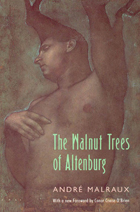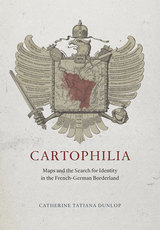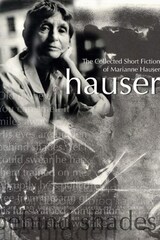3 books about Alsace (France)

André Malraux
University of Chicago Press
"One of the key texts of Malraux's work . . . [its] pages must be counted among the most haunting in all of twentieth century literature."—Victor Brombert
"The description of the gas attack on the Russian front in 1915 will never be forgotten by anyone who has read it. . . . [Malraux] writes with the precision, the certitude and the authority of an obsessed person who knows that he has found the essence of what he has been looking for."—Conor Cruise O'Brien, from the Foreword
Malraux's greatest novel, Man's Fate, gave a grim, lurid picture of human suffering. [The Walnut Trees of Altenburg], written by a life-long observer of violent upheaval and within the shadows of World War II, gives a calm, thoughtful vision of humanistic endeavor that can transcend the absurdity of existence. Mature readers will find this a rewarding visit to one of the most accomplished writers of our time."—Choice
"The description of the gas attack on the Russian front in 1915 will never be forgotten by anyone who has read it. . . . [Malraux] writes with the precision, the certitude and the authority of an obsessed person who knows that he has found the essence of what he has been looking for."—Conor Cruise O'Brien, from the Foreword
Malraux's greatest novel, Man's Fate, gave a grim, lurid picture of human suffering. [The Walnut Trees of Altenburg], written by a life-long observer of violent upheaval and within the shadows of World War II, gives a calm, thoughtful vision of humanistic endeavor that can transcend the absurdity of existence. Mature readers will find this a rewarding visit to one of the most accomplished writers of our time."—Choice
[more]

Cartophilia
Maps and the Search for Identity in the French-German Borderland
Catherine Tatiana Dunlop
University of Chicago Press, 2015
The period between the French Revolution and World War II was a time of tremendous growth in both mapmaking and map reading throughout Europe. There is no better place to witness this rise of popular cartography than in Alsace-Lorraine, a disputed borderland that the French and Germans both claimed as their national territory. Desired for its prime geographical position and abundant natural resources, Alsace-Lorraine endured devastating wars from 1870 to 1945 that altered its borders four times, transforming its physical landscape and the political allegiances of its citizens. For the border population whose lives were turned upside down by the French-German conflict, maps became essential tools for finding a new sense of place and a new sense of identity in their changing national and regional communities.
Turning to a previously undiscovered archive of popular maps, Cartophilia reveals Alsace-Lorraine’s lively world of citizen mapmakers that included linguists, ethnographers, schoolteachers, hikers, and priests. Together, this fresh group of mapmakers invented new genres of maps that framed French and German territory in original ways through experimental surveying techniques, orientations, scales, colors, and iconography. In focusing on the power of “bottom-up” maps to transform modern European identities, Cartophilia argues that the history of cartography must expand beyond the study of elite maps and shift its emphasis to the democratization of cartography in the modern world.
Turning to a previously undiscovered archive of popular maps, Cartophilia reveals Alsace-Lorraine’s lively world of citizen mapmakers that included linguists, ethnographers, schoolteachers, hikers, and priests. Together, this fresh group of mapmakers invented new genres of maps that framed French and German territory in original ways through experimental surveying techniques, orientations, scales, colors, and iconography. In focusing on the power of “bottom-up” maps to transform modern European identities, Cartophilia argues that the history of cartography must expand beyond the study of elite maps and shift its emphasis to the democratization of cartography in the modern world.
[more]

The Collected Short Fiction of Marianne Hauser
Marianne Hauser
University of Alabama Press, 2005
Marianne Hauser's short fiction is a literary documentary of exile, the other-worldly travelogue of an imagination permanently displaced. These accounts of expatriates and lost children situate us in foreign realms, between the titillating intimacies of strangers and looming brutalities we can never quite see. In Hauser's fiction, expatriation is not a historical accident but a condition as essential to humans as breathing or speech. A young boy's suicide in "Heartlands Beat" or a child's vision of her piano teacher's corpse invoke the permanent dislocations that adulthood can never overcome. It is as though birth were, for Hauser, the great forced migration, an incomprehensible banishment from some homeland every child can remember. Her characters gaze in bewilderment at the crude and violent landscape that, through preposterous twistings, they have come to occupy, wondering how they could have ended so incongruously, unable to imagine any dwelling but here. Beautiful fabrications from the writer about whom Anais Nin remarked, "She deftly weaves the strange, the unknown, the unfamiliar, the perverse, into a fabric of human fallibilities that draws drama and farce close to us."
[more]
READERS
Browse our collection.
PUBLISHERS
See BiblioVault's publisher services.
STUDENT SERVICES
Files for college accessibility offices.
UChicago Accessibility Resources
home | accessibility | search | about | contact us
BiblioVault ® 2001 - 2024
The University of Chicago Press









